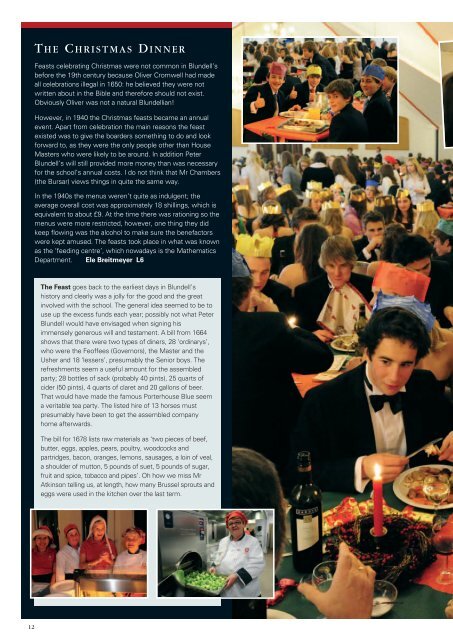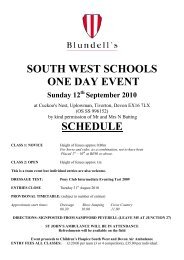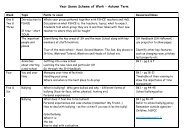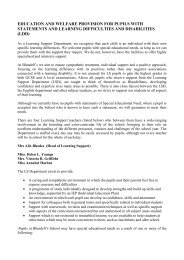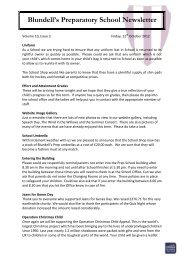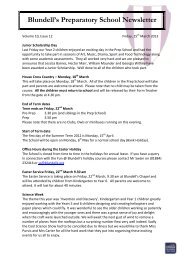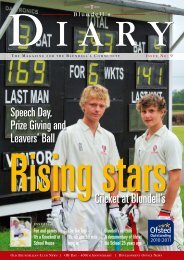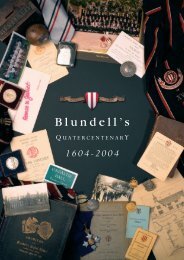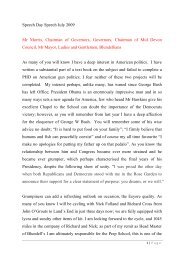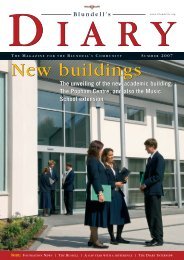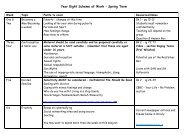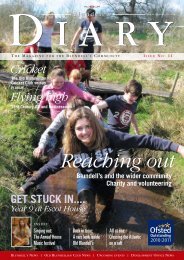Issue 2 Winter 2008 (6.3 MB) - Blundell's School
Issue 2 Winter 2008 (6.3 MB) - Blundell's School
Issue 2 Winter 2008 (6.3 MB) - Blundell's School
Create successful ePaper yourself
Turn your PDF publications into a flip-book with our unique Google optimized e-Paper software.
T HE C HRISTMAS D INNERFeasts celebrating Christmas were not common in Blundell’sbefore the 19th century because Oliver Cromwell had madeall celebrations illegal in 1650: he believed they were notwritten about in the Bible and therefore should not exist.Obviously Oliver was not a natural Blundellian!However, in 1940 the Christmas feasts became an annualevent. Apart from celebration the main reasons the feastexisted was to give the boarders something to do and lookforward to, as they were the only people other than HouseMasters who were likely to be around. In addition PeterBlundell’s will still provided more money than was necessaryfor the school’s annual costs. I do not think that Mr Chambers(the Bursar) views things in quite the same way.In the 1940s the menus weren’t quite as indulgent; theaverage overall cost was approximately 18 shillings, which isequivalent to about £9. At the time there was rationing so themenus were more restricted, however, one thing they didkeep flowing was the alcohol to make sure the benefactorswere kept amused. The feasts took place in what was knownas the ‘feeding centre’, which nowadays is the MathematicsDepartment. Ele Breitmeyer L6The Feast goes back to the earliest days in Blundell’shistory and clearly was a jolly for the good and the greatinvolved with the school. The general idea seemed to be touse up the excess funds each year; possibly not what PeterBlundell would have envisaged when signing hisimmensely generous will and testament. A bill from 1664shows that there were two types of diners, 28 ‘ordinarys’,who were the Feoffees (Governors), the Master and theUsher and 18 ‘lessers’, presumably the Senior boys. Therefreshments seem a useful amount for the assembledparty; 28 bottles of sack (probably 40 pints), 25 quarts ofcider (50 pints), 4 quarts of claret and 20 gallons of beer.That would have made the famous Porterhouse Blue seema veritable tea party. The listed hire of 13 horses mustpresumably have been to get the assembled companyhome afterwards.The bill for 1678 lists raw materials as ‘two pieces of beef,butter, eggs, apples, pears, poultry, woodcocks andpartridges, bacon, oranges, lemons, sausages, a loin of veal,a shoulder of mutton, 5 pounds of suet, 5 pounds of sugar,fruit and spice, tobacco and pipes’. Oh how we miss MrAtkinson telling us, at length, how many Brussel sprouts andeggs were used in the kitchen over the last term.12


